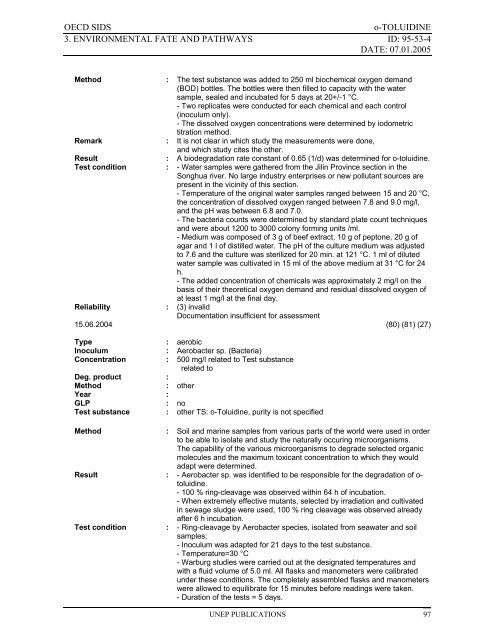o-TOLUIDINE CAS N°: 95-53-4 - UNEP Chemicals
o-TOLUIDINE CAS N°: 95-53-4 - UNEP Chemicals
o-TOLUIDINE CAS N°: 95-53-4 - UNEP Chemicals
Create successful ePaper yourself
Turn your PDF publications into a flip-book with our unique Google optimized e-Paper software.
OECD SIDS o-<strong>TOLUIDINE</strong><br />
3. ENVIRONMENTAL FATE AND PATHWAYS ID: <strong>95</strong>-<strong>53</strong>-4<br />
DATE: 07.01.2005<br />
Method : The test substance was added to 250 ml biochemical oxygen demand<br />
(BOD) bottles. The bottles were then filled to capacity with the water<br />
sample, sealed and incubated for 5 days at 20+/-1 °C.<br />
- Two replicates were conducted for each chemical and each control<br />
(inoculum only).<br />
- The dissolved oxygen concentrations were determined by iodometric<br />
titration method.<br />
Remark : It is not clear in which study the measurements were done,<br />
and which study cites the other.<br />
Result : A biodegradation rate constant of 0.65 (1/d) was determined for o-toluidine.<br />
Test condition : - Water samples were gathered from the Jilin Province section in the<br />
Songhua river. No large industry enterprises or new pollutant sources are<br />
present in the vicinity of this section.<br />
- Temperature of the original water samples ranged between 15 and 20 °C,<br />
the concentration of dissolved oxygen ranged between 7.8 and 9.0 mg/l,<br />
and the pH was between 6.8 and 7.0.<br />
- The bacteria counts were determined by standard plate count techniques<br />
and were about 1200 to 3000 colony forming units /ml.<br />
- Medium was composed of 3 g of beef extract, 10 g of peptone, 20 g of<br />
agar and 1 l of distilled water. The pH of the culture medium was adjusted<br />
to 7.6 and the culture was sterilized for 20 min. at 121 °C. 1 ml of diluted<br />
water sample was cultivated in 15 ml of the above medium at 31 °C for 24<br />
h.<br />
- The added concentration of chemicals was approximately 2 mg/l on the<br />
basis of their theoretical oxygen demand and residual dissolved oxygen of<br />
at least 1 mg/l at the final day.<br />
Reliability : (3) invalid<br />
Documentation insufficient for assessment<br />
15.06.2004 (80) (81) (27)<br />
Type : aerobic<br />
Inoculum : Aerobacter sp. (Bacteria)<br />
Concentration : 500 mg/l related to Test substance<br />
related to<br />
Deg. product :<br />
Method : other<br />
Year :<br />
GLP : no<br />
Test substance : other TS: o-Toluidine, purity is not specified<br />
Method : Soil and marine samples from various parts of the world were used in order<br />
to be able to isolate and study the naturally occuring microorganisms.<br />
The capability of the various microorganisms to degrade selected organic<br />
molecules and the maximum toxicant concentration to which they would<br />
adapt were determined.<br />
Result : - Aerobacter sp. was identified to be responsible for the degradation of otoluidine.<br />
- 100 % ring-cleavage was observed within 64 h of incubation.<br />
- When extremely effective mutants, selected by irradiation and cultivated<br />
in sewage sludge were used, 100 % ring cleavage was observed already<br />
after 6 h incubation.<br />
Test condition : - Ring-cleavage by Aerobacter species, isolated from seawater and soil<br />
samples;<br />
- Inoculum was adapted for 21 days to the test substance.<br />
- Temperature=30 °C<br />
- Warburg studies were carried out at the designated temperatures and<br />
with a fluid volume of 5.0 ml. All flasks and manometers were calibrated<br />
under these conditions. The completely assembled flasks and manometers<br />
were allowed to equilibrate for 15 minutes before readings were taken.<br />
- Duration of the tests = 5 days.<br />
<strong>UNEP</strong> PUBLICATIONS 97
















